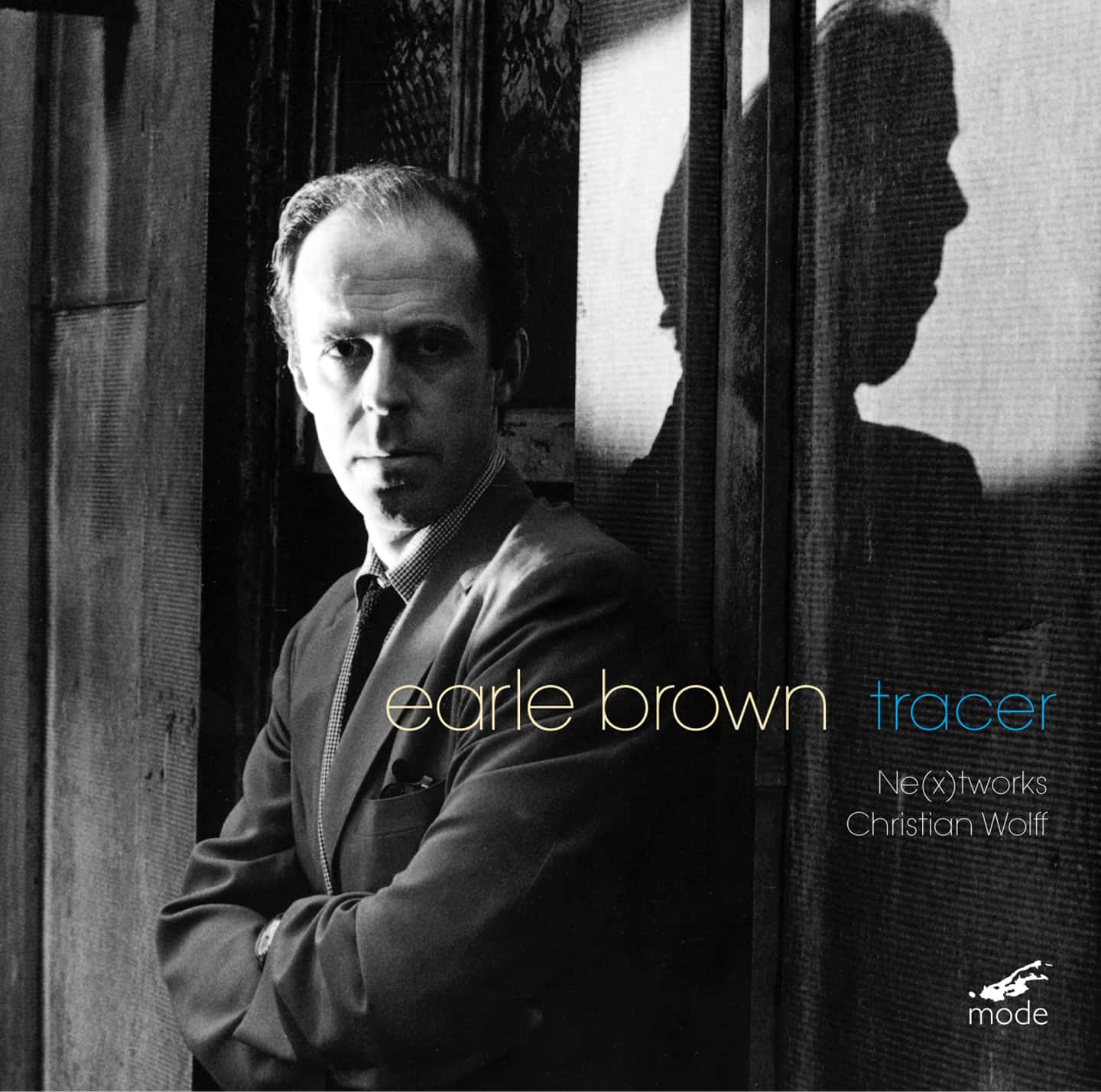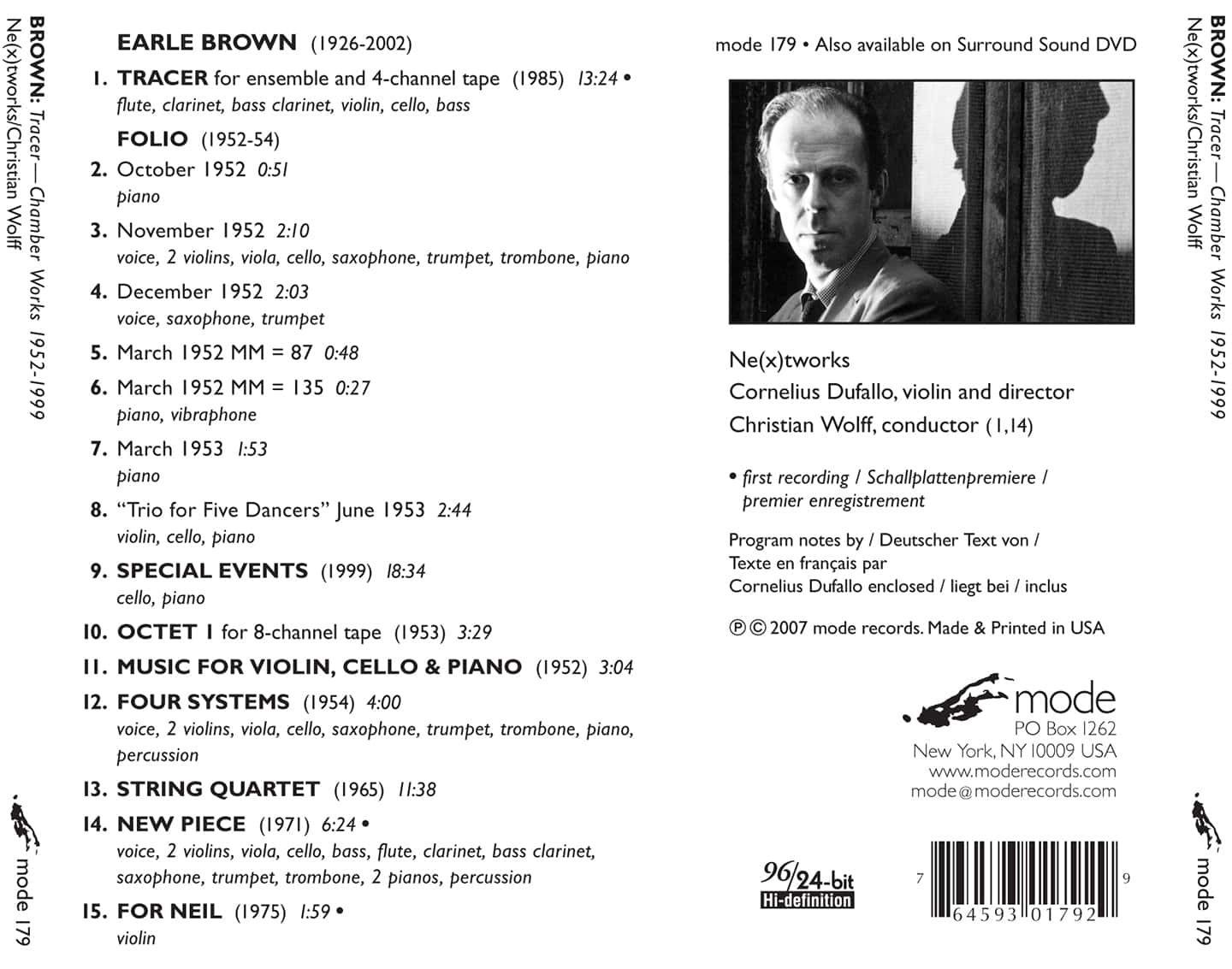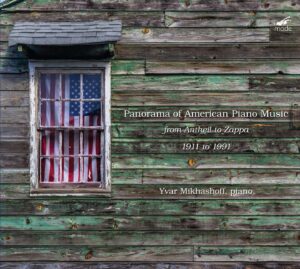Tracer - CD
Compact disc; also available on Surround sound DVD. For various configurations of instruments and voice; the 2nd-8th, 12th, and 15th works are graphic scores; the 1st and 13th-14th works are open form scores; the 10th work originally for 8-channel tape (now lost), here presented in a stereo mixdown of the 4-channel master which the composer made. Includes program notes in English with French and German translations on insert. Includes program notes. Streaming audio. Title from image of compact disc cover on Web page (viewed Nov. 21, 2008) Ne(x)tworks (Joan La Barbara, voice ; Cornelius Dufallo, violin ; Ariana Kim, violin ; Kenji Bunch, viola ; Yves Dharamraj, violoncello ; Brian McWhorter, trumpet ; Chris McIntyre, trombone ; Taimur Sullivan, saxophones ; Stephen Gosling, piano, prepared piano) ; with Jennifer Grimm, flute ; Carol McGonnell, clarinet ; Benjamin Fingland, bass clarinet ; Stephen Sas, double bass ; Micah Silver, piano ; Aaron Trant, percussion ; Christian Wolff, conductor. Recorded at The Performing Arts Center at the State University at Purchase, New York, June 9-10, 2005. Also available as compact disc; previously issued as Mode Records mode 179.
Tracer for ensemble and 4-channel tape (1985) (13:24)
for flute, clarinet, bass clarinet, violin, cello, bass
Folio (1952-54)
October (1952) (0:51)
for pianos
November (1952) (2:08)
for voice, 2 violins, viola, cello, saxophone, trumpet, trombone,
piano
December (1952) (3:36)
for voice, saxophone, trumpet
March MM = 87 (0:48)
March MM = 135 (0:27)
for piano, vibraphone
March (1953) (1:53)
for violin, cello, piano
“Trio for Five Dancers” (June 1953) (1:02)
for violin, cello, piano
Special Events (1999) (18:34)
for cello, piano
Octet 1 (1953) (3:29)
for 8-channel tape
Music for Violin, Cello & Piano (1952) (3:04)
Four Systems (1954) (4:00)
for voice, 2 violins, viola, cello, saxophone, trumpet, trombone, piano, percussion
String Quartet (1965) (11:38)
New Piece (1971) (6:24)
for voice, 2 violins, viola, cello, bass, flute, clarinet, bass clarinet, saxophone, trumpet, trombone, 2 pianos, percussion
For Neil (1975) (1:59)
for violin
Ne(x)tworks Ensemble
Christian Wolff, conductor (Tracer, New Piece)
Earle Brown first encountered the work of Alexander Calder in 1948, whose mobile sculptures Brown saw as a visual embodiment of the variable (impermanent) aesthetic that he was striving to create. This “Calder aesthetic” stayed with Brown throughout his several stylistic shifts. Whether he was writing twelve-tone serial music (Music for Violin, Cello, and Piano), conceptual graphic scores (Folio and Four Systems), composed material/open form scores (String Quartet, New Piece and Tracer), or “spontaneously composed” music (Special Events), all of his music shares Calder’s sense of integral but “floating” variations, which Brown described as, “the construction of units and their placement in a flexible situation that subjects the original relationships to constant and virtually unpredictable, but inherent, change (the movement of the units as well as the movement of the viewer).”
Brown belonged to a group of composers that today is referred to as the “The New York School” (the group active in New York in the 1950s that included Brown, John Cage, Morton Feldman, and Christian Wolff.)
The works recorded on this disc represent several of Brown’s compositional styles. At least one piece was selected from every decade of his career, from the 1950s to the 1990s. The ensemble size varies from one player to fourteen.
Performers include Christian Wolff and vocalist Joan La Barbara, both of whom knew and worked with Brown for many years.
Several works call for spatialized ensembles spread throughout the hall, perfect for the surround-sound medium.
The classic tape piece Octet is presented in new high-resolution transfers from analogue tapes provided by The Earle Brown Foundation in its 4-channel mix by the composer.
The release of this DVD marks Ne(x)tworks’ recorded debut. Ne(x)tworks is a collaborative ensemble of musicians creating and interpreting work that features a dynamic relationship between composition and improvisation. In performance and recordings, the group locates pathways into various types of notation systems and interfaces, striving for a meaningful dialogue with the past, present, and future of creative music.
Additional features on the DVD:
- This is the first DVD of Earle Brown’s music.
- All performances captured with full video.
- 36-minute video interview with Susan Sollins (Brown’s wife and an expert on his music), Cornelius Dufallo (founder of the Ne(x)tworks ensemble and Brown’s godson), and Micah Silver (former director of The Earle Brown Foundation) on Earle Brown’s life and work. The interview, filmed in HD (high-definition) is presented in 16:9 widescreen aspect ratio.
- Hi-resolution 24-bit 5.1 surround recording in DTS and Dolby Digital.
Language : The 3rd-4th, 12th, and 14th works incorporate wordless vocalizations.
Reviews
The Wire: “Recordings of the Year” for 2007
Earle Brown
Tracer
Ne(x)tworks
Mode 179
Continuing a Celebration of a Composer (and Godfather)
The innovative American composer Earle Brown, who died in 2002, would have celebrated his 80th birthday last year. The new-music ensemble Ne(x)tworks observed the occasion by recording a number of his chamber works for Mode Records, a New York label widely admired for its devotion to modern music. The recording was released on Tuesday, and the group celebrated with a retrospective of Mr. Brown’s music at the Chelsea Art Museum.
Ne(x)tworks, whose members also compose and improvise, has especially close links to Mr. Brown. The ensemble’s director, the violinist Cornelius Dufallo, is the son of the conductor Richard Dufallo, a champion of new music who appointed Mr. Brown his son’s godfather. And one of the earliest public appearances by the members of Ne(x)tworks was a 2002 performance of Mr. Brown’s music in the singer Joan La Barbara’s Carnegie Hall series When Morty Met John.
Those connections have made Ne(x)tworks a compelling advocate for Mr. Brown’s music. “Music for Violin, Cello and Piano,” a serialist miniature from 1952, was played twice on Tuesday by Mr. Dufallo, the cellist Yves Dharamraj and the pianist Stephen Gosling. In sharp contrast to that work’s chiseled exactitude, the String Quartet (1965) represented the composer’s later style of open-score notation, in which a formal structure offered leeway for improvisational flexibility. Opening the work at a whisper, Mr. Dufallo, Mr. Dharamraj, the violinist Ariana Kim and the violist Kenji Bunch proceeded through passages of chirps and pops, robust solo lines, assertive chords and agitated scribbles.
The rest of the program was devoted to “Folio and Four Systems,” a collection of inventive graphic scores created between 1952 and 1954. Ms. La Barbara offered whoops, ululations and gargles in a lively account of “December 1952,” the score of which resembles a Mondrian painting. The trombonist Chris McIntyre employed growling multiphonics and recorded urban noise in “November 1952,” and Mr. Gosling applied fingers, a percussion mallet and a drum brush to piano strings in “1953.”
In a mesmerizing rendition of “Four Systems,” the harpist Shelley Burgon collaborated with Miguel Frasconi, who rubbed sonorous goblets and produced chiming tones on shards of glass. The concert ended with a reprise of “December 1952” featuring the entire ensemble. That the second version was similar in detail and duration to Ms. La Barbara’s earlier solo account, despite the volition of eight additional performers, neatly illustrated Mr. Brown’s uncanny knack for focusing the energies of freewheeling performers.
— Steve Smith, New York Times Music Review, April 19, 2007



